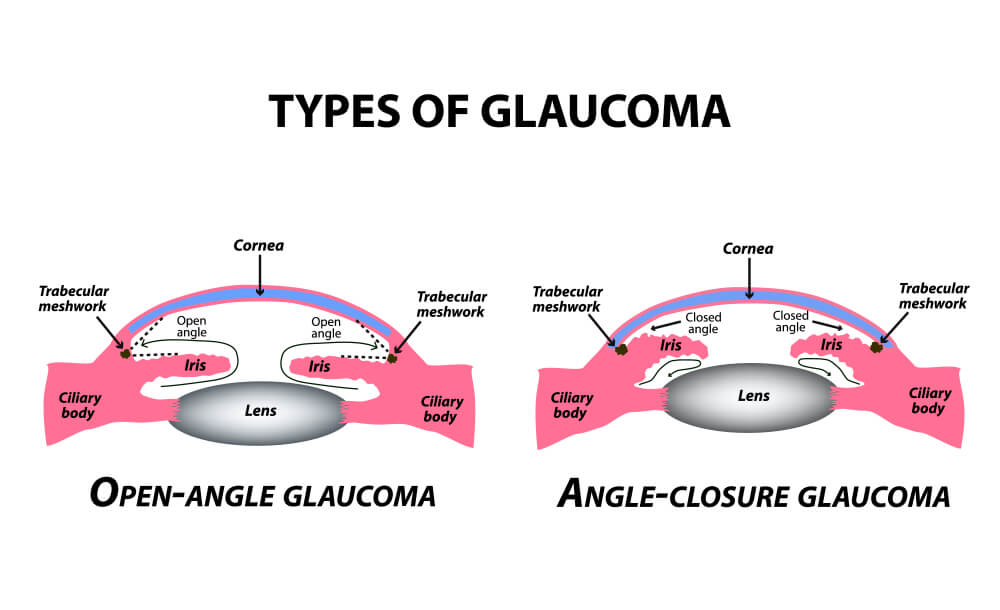Home » Glaucoma

It’s estimated that three million Americans have glaucoma but only about half of them have been diagnosed. Glaucoma is often called “the silent thief of sight” because there is often no pain or symptoms present until noticeable, irreversible vision loss occurs. At St. Luke’s, we have a team of experts to take care of your medical and surgical needs.
Glaucoma is a disease caused by increased intraocular pressure (IOP) resulting either from a malformation or malfunction of the eye’s drainage structures. The eye constantly produces aqueous, the clear fluid that fills the anterior chamber (the space between the cornea and iris). The aqueous filters out of the anterior chamber through a complex drainage system. The delicate balance between the production and drainage of aqueous determines the eye’s intraocular pressure (IOP). Most people’s IOPs fall between 8 and 21.
However, some eyes can tolerate higher pressures than others. That’s why it may be normal for one person to have higher pressure than another.
Left untreated, an elevated IOP can cause irreversible damage to the optic nerve and retinal fibers. This can result in a progressive, permanent loss of vision. However, early detection and treatment can slow, or even halt, the progression of the disease.
Open angle (also referred to as chronic open angle or primary open angle) is the most common type of glaucoma. The anterior structures appear normal but pressure builds and the optic nerve and retina can be damaged. Eye drops are often prescribed to lower the pressure. In some cases, if pressure cannot be adequately managed with drops, surgery may be necessary.
Acute angle closure accounts for about 10% of glaucoma cases. Acute angle closure occurs because the space between the iris and cornea is too narrow for the aqueous humor to pass through. Pressure rises, sometimes sharply, and this condition is called an angle closure attack. Symptoms may include: eye pain, nausea, blurred vision, rainbows around lights, and a red eye. This problem is a medical emergency and should be treated by an ophthalmologist immediately.

Secondary glaucoma is used to describe an elevation in eye pressure that results from another problem within the eye such as: inflammation, trauma, diabetes, tumor, and certain medications. For this type, both the glaucoma and the underlying problem must be treated.
Congenital glaucoma is a rare form of glaucoma that most commonly presents in infants and young children. Surgery is required in most cases.
Glaucoma treatment may include prescription eye drops, laser surgery, microsurgery or even a combination of methods. Sometimes, a combination of medications that complement each other are necessary to reduce the pressure adequately. This disease is often painless, therefore it is important to follow the regimen of drops as outlined by your doctor to prevent damage to the structures of your eye. Surgery is indicated when medical treatment fails to lower the eye pressure. There are several types of procedures that can be done. Some are done in the office and others must be completed in the operating room. The objective of any glaucoma operation is to allow the fluid to drain from the eye more efficiently. Early detection, surgical or non-surgical treatment and strict compliance to medication instructions provide the best opportunity to preservation of sight.
Schedule a comprehensive eye exam including intraocular pressure measurement.
We proudly serve patients at our eye clinics in Tarpon Springs, Tampa, St. Petersburg, Clearwater, Spring Hill, Wesley Chapel and in The Villages at Lake Sumter Landing and Brownwood. Our philosophy is to treat those we serve as though they are a member of our own families. From the first phone call or email to the follow-up visit and beyond, we’re here to serve you. Our goal is to help preserve and optimize your vision.

